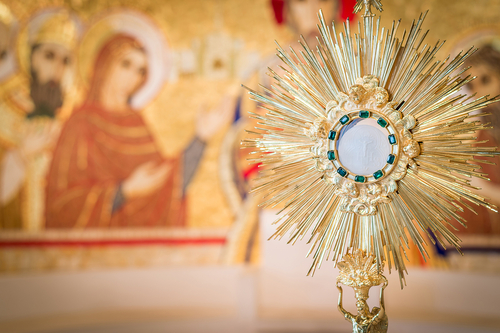The ritual book of the church that provides instruction, pastoral practice, and various forms for the exposition and adoration of the Blessed Sacrament is called the Order for the Solemn Exposition of the Holy Eucharist, (Liturgical Press, 1993).
This ritual book is the standard for parishes when using this form of devotional prayer. This ritual book needs to be in every sacristy of every parish, to be used when this devotional prayer is being offered.
As with all church ritual books, the text begins with an introduction which, in this case, gives a very brief history of 40 hours devotion, a reflection on the mystery of the Eucharist, and some instruction on the details and various forms of this devotional prayer. Liturgical Press also publishes a separate companion book, “Music Accompaniment for Eucharistic Adoration,” which might be helpful to parish musicians.
The most important element to remember when offering this prayer in parishes is that it flows from the celebration of the Eucharist at Mass. The fifth paragraph in the introduction, which is taken directly from the Roman Ritual: Holy Communion and Worship of the Eucharist Outside of Mass, supports this awareness: “When the faithful adore Christ present in the sacrament, they should remember that this presence derives from the sacrifice (the Mass) and is directed toward sacramental and spiritual communion.”
In the “Directory on Popular Piety and the Liturgy: Principles and Guidelines, 2002,” by the Vatican Congregation for Divine Worship and the Discipline of the Sacraments, regarding Eucharistic Adoration, states: “Its initial form derives from Holy Thursday and the altar of repose… This adoration is a most apt way of expressing the connection between the celebration of the memorial of the Lord’s Sacrifice (the Mass) and his continued presence in the Sacrament of the Altar. The reservation of the Sacred Species, so as to be able to administer Viaticum to the sick at any time, encouraged the practice among the faithful of recollection before the tabernacle and to worship Christ present in the Sacrament (Paul VI Mysterii paschalis, 1969)…the devotion prompting the faithful to visit the blessed sacrament draws them into an ever deeper share in the paschal mystery and leads them to respond gratefully to the gift of him who through his humanity constantly pours divine life into the members of his Body” (Sacred Congregation of Rites, Eucharisticum mysterium).
Adoration of the Blessed Sacrament can be observed either as a simple visit by an individual to pray before the Blessed Sacrament, or adoration of the Blessed Sacrament exposed for a period of time in a pyx or monstrance, following the norms outlined in the ritual book named above
During extended periods of adoration, we are encouraged to read Scripture, sing hymns and spiritual songs, celebrate the Liturgy of the Hours and pray and reflect in silence. The ritual book, provides us with the texts of the Liturgy of the Hours: Evening Prayer and Morning Prayer, taken from the office for the Solemnity of the Body and Blood of Christ; Services of Prayer and Praise, given as models of prayer that can be used during periods of exposition; and Closing Celebrations — one in which the blessed sacrament is returned to the tabernacle before the celebration of the Mass, after which exposition continues after the sharing in communion, followed by Benediction (Eucharistic blessing offered by the priest) and Reposition (returning of the Blessed Sacrament to the tabernacle); and one entitled Closing Celebration Outside Mass.
This celebration is the conclusion of a long period of exposition that most likely flowed from an earlier celebration of Mass. For this time of prayer, the presiding minister can be a priest, deacon or lay minister. If a lay minister presides, the incensing of the eucharist is omitted, the words of the greeting are different and the benediction before reposition is omitted. The content of this closing celebration is a Liturgy of the Word.
One brief chapter in this ritual book gives instruction for the celebration of Mass when the period of Exposition is over several days. “When solemn exposition takes place over a period of several days, the eucharist may be celebrated one or more times each day, according to pastoral need. However, Mass may not be celebrated before the exposed sacrament. The eucharist is to be replaced in the tabernacle before the celebration of Mass begins, unless exposition takes place in a separate chapel and several people remain there to continue adoration. It is appropriate that a new host be consecrated for the continuation of exposition following the Mass and that the host previously used for exposition be consumed at communion” (117).
Appendix I, II and III of this ritual book include additional scripture readings, litanies and prayers and suggested music.
Start your day with Always Forward, our award-winning e-newsletter. Get this smart, handpicked selection of the day’s top news, analysis, and opinion, delivered to your inbox. Sign up absolutely free today!

